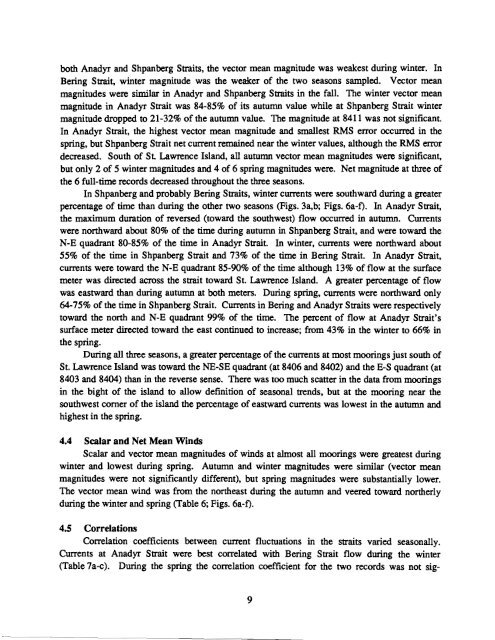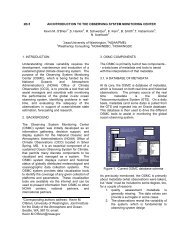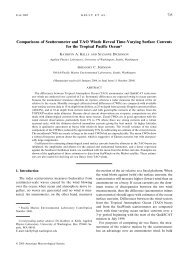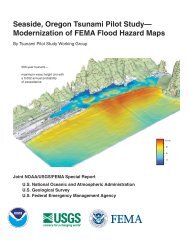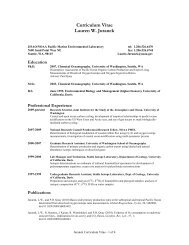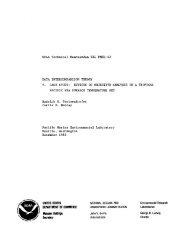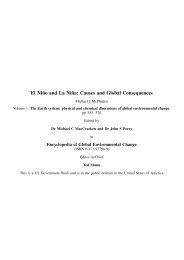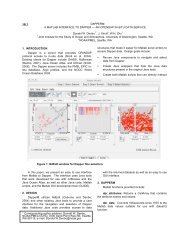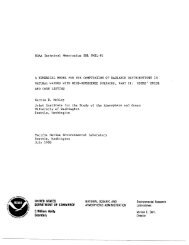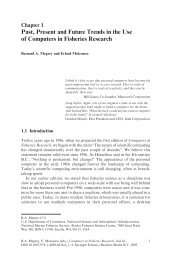Oceanographic conditions on the northern Bering Sea shelf: 1984 ...
Oceanographic conditions on the northern Bering Sea shelf: 1984 ...
Oceanographic conditions on the northern Bering Sea shelf: 1984 ...
You also want an ePaper? Increase the reach of your titles
YUMPU automatically turns print PDFs into web optimized ePapers that Google loves.
oth Anadyr and Shpanberg Straits, <strong>the</strong> vector mean magnitude was weakest during winter. In<br />
<strong>Bering</strong> Strait, winter magnitude was <strong>the</strong> weaker of <strong>the</strong> two seas<strong>on</strong>s sampled. Vector mean<br />
magnitudes were similar in Anadyr and Shpanberg Straits in <strong>the</strong> fall. The winter vector mean<br />
magnitude in Anadyr Strait was 84-85% of its autumn value while at Shpanberg Strait winter<br />
magnitude dropped to 21-32% of <strong>the</strong> autumn value. The magnitude at 8411 was not significant.<br />
In Anadyr Strait, <strong>the</strong> highest vector mean magnitude and smallest RMS error occurred in <strong>the</strong><br />
spring, but Shpanberg Strait net current remained near <strong>the</strong> winter values, although <strong>the</strong> RMS error<br />
decreased. South of St. Lawrence Island, all autumn vector mean magnitudes were significant,<br />
but <strong>on</strong>ly 2 of 5 winter magnitudes and 4 of 6 spring magnitudes were. Net magnitude at three of<br />
<strong>the</strong> 6 full-time records decreased throughout <strong>the</strong> three seas<strong>on</strong>s.<br />
In Shpanberg and probably <strong>Bering</strong> Straits, winter currents were southward during a greater<br />
percentage of time than during <strong>the</strong> o<strong>the</strong>r two seas<strong>on</strong>s (Figs.3a,b; Figs.6a-f). In Anadyr Strait,<br />
<strong>the</strong> maximum durati<strong>on</strong> of reversed (toward <strong>the</strong> southwest) flow occurred in autumn. Currents<br />
were northward about 80% of <strong>the</strong> time during autumn in Shpanberg Strait, and were toward <strong>the</strong><br />
N-E quadrant 80-85% of <strong>the</strong> time in Anadyr Strait. In winter, currents were northward about<br />
55% of <strong>the</strong> time in Shpanberg Strait and 73% of <strong>the</strong> time in <strong>Bering</strong> Strait. In Anadyr Strait,<br />
currents were toward <strong>the</strong> N-E quadrant 85-90% of <strong>the</strong> time although 13% of flow at <strong>the</strong> surface<br />
meter was directed across <strong>the</strong> strait toward St. Lawrence Island. A greater percentage of flow<br />
was eastward than during autumn at both meters. During spring, currents were northward <strong>on</strong>ly<br />
64-75% of <strong>the</strong> time in Shpanberg Strait. Currents in <strong>Bering</strong> and Anadyr Straits were respectively<br />
toward <strong>the</strong> north and N-E quadrant 99% of <strong>the</strong> time. The percent of flow at Anadyr Strait's<br />
surface meter directed toward <strong>the</strong> east c<strong>on</strong>tinued to increase; from 43% in <strong>the</strong> winter to 66% in<br />
<strong>the</strong> spring.<br />
During all three seas<strong>on</strong>s, a greater percentage of<strong>the</strong> currents at most moorings just south of<br />
St. Lawrence Island was toward <strong>the</strong> NE-SE quadrant (at 8406 and 8402) and <strong>the</strong> E-S quadrant (at<br />
8403 and 8404) than in <strong>the</strong> reverse sense. There was too much scatter in <strong>the</strong> data from moorings<br />
in <strong>the</strong> bight of <strong>the</strong> island to allow definiti<strong>on</strong> of seas<strong>on</strong>al trends, but at <strong>the</strong> mooring near <strong>the</strong><br />
southwest corner of <strong>the</strong> island <strong>the</strong> percentage of eastward currents was lowest in <strong>the</strong> autumn and<br />
highest in <strong>the</strong> spring.<br />
4.4 Scalar and Net Mean Winds<br />
Scalar and vector mean magnitudes of winds at almost all moorings were greatest during<br />
winter and lowest during spring. Autumn and winter magnitudes were similar (vector mean<br />
magnitudes were not significantly different), but spring magnitudes were substantially lower.<br />
The vector mean wind was from <strong>the</strong> nor<strong>the</strong>ast during <strong>the</strong> autumn and veered toward nor<strong>the</strong>rly<br />
during <strong>the</strong> winter and spring (Table 6; Figs. 6a-f).<br />
4.5 Correlati<strong>on</strong>s<br />
Correlati<strong>on</strong> coefficients between current fluctuati<strong>on</strong>s in <strong>the</strong> straits varied seas<strong>on</strong>ally.<br />
Currents at Anadyr Strait were best correlated with <strong>Bering</strong> Strait flow during <strong>the</strong> winter<br />
(Table 7a-c). During <strong>the</strong> spring <strong>the</strong> correlati<strong>on</strong> coefficient for <strong>the</strong> two records was not sig-<br />
9


